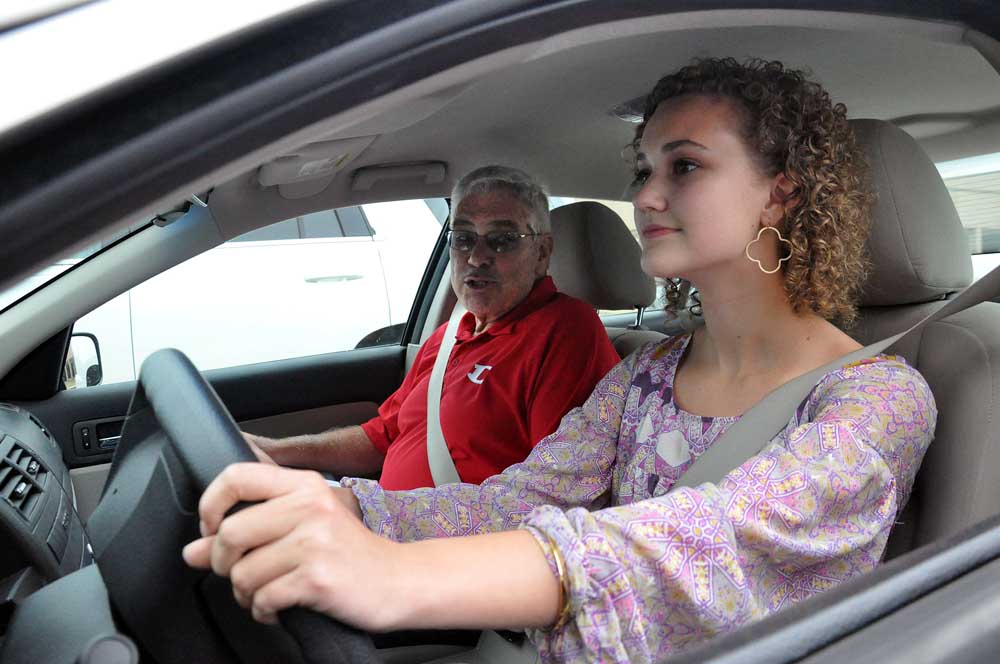Distracted drivers
Published 10:54 pm Saturday, May 21, 2016

- Caroline Coleman, 15, practices her driving with driver's ed teacher Jim Bennett at Dalton High School Friday.
Every time an inexperienced driver gets behind a wheel, the consequences could be deadly.
From unsafe driving practices, distracted driving or the mix of driving and alcohol, the combination of teens and driving is the leading cause of accidental death in the country for teenagers, according to the Insurance Institute for Highway Safety.
Trending
“Distracted driving is the biggest thing we try to focus on with new drivers,” said Rhett Parrott, a driver’s education instructor at Dalton High School. “They do have more distractions than ever before, but any type of distraction is a concern. Be it passengers, radio, electronics, those are the things we stress. We really try to make them aware of those things and avoid those distractions as much as possible.”
According to a recent survey by CarInsurance.com, Georgia is doing a better job of instituting rules and regulations to protect teen drivers, but more can be done.
An analysis of the 50 states and District of Columbia based on safety and insurance cost factors shows that Massachusetts, Maryland and Alaska have the safest driving environment for teens, while Montana, North Dakota and Louisiana have the worst, according to the survey.
CarInsurance.com also surveyed 500 parents of teen drivers to find out about their children’s driving habits. Key findings show the majority of surveyed parents (59 percent) have allowed their kids to break at least one graduated driver’s license rule, though many (64 percent) rate their teen driver’s performance as “fairly scary” or worse.
Georgia was ranked as the 18th safest state on the survey list, but the state was sixth nationwide in the number of teen driving deaths per year (62 in 2014) behind California, Texas, Florida, North Carolina and Ohio.
“If we are really going to make a difference, we really have to put all of our efforts into raising awareness,” said Georgia Department of Driver Services Commissioner Bert Brantley. “Now, driving is so common and we do it so much for longer periods of time, we want to achieve other things while we are driving — texting, talking on the phone, talking to our friends in the back seat, eating, makeup, whatever. Every spot we are higher on that list, it is really lives that are being saved. These are teenagers and our future and we need to protect them and have them around.”
Trending
According to the Governor’s Office of Highway Safety, graduated driver’s license rules have been in effect since 2007 with the passage of what is known as “Joshua’s Law.” All 16-year-olds applying for a Class D driver’s license must complete an approved driver education course and complete a total of 40 hours of supervised driving, six hours of which must be at night, with a parent or guardian’s sworn verification that these driving requirements have been met.
Any Georgia resident who has not completed an approved driver education course must be at least 17 years old to be eligible for a Class D driver’s license. He or she must have completed a total of at least 40 hours of supervised driving, including at least six hours at night.
It is that supervision component that Dalton High driving instructor Jim Bennett says has changed during his 20-plus years as an instructor.
“One of the biggest things is more distractions and kids aren’t getting the hands-on experience like they used to,” Bennett said. “I learned how to drive out in the middle of a field, but that isn’t the way it is now. Because of lifestyle now, the parents don’t have enough time to get a lot of driving time in. I think that is the biggest thing. It isn’t necessarily the parents’ fault, but kids aren’t getting that kind of experience anymore.”
More than 200 rising freshmen and sophomores have enrolled for the 2016-17 program at Dalton High School, which costs an extra $50 to complete. Most advertised driver’s training courses through private companies in the area range from $75 to $100 to enroll.
Follow the rules
Local students say the experience of taking the class has helped them be more aware of the dangers, but they also acknowledge they and their friends need to do more to be safe.
“A lot of kids aren’t happy about those rules, but they are for our own safety and we need those rules even if we don’t like them,” said Jack Ridley, 15. “Teens are really bad about always being on their phone and that is a real danger to them and others on the road. I think that does affect teens more than adults. In some cases, they are wanting to keep up with their friends and can’t really put it down even if it is just a short drive somewhere.”
The distractions — texting, talking on cellphones, friends in the car — all add up to dangers on the road.
“We probably don’t take it as seriously as we should, but I think most of my friends take it pretty seriously,” said Caroline Coleman, 15. “Probably just obeying the law to drive your friends around would be the thing we don’t like the most. We want to drive with our friends, but you have to wait.”
“They don’t think anything about talking on their phone or texting, and that is just part of their lifestyle. It is how they have grown up,” Bennett said. “Joshua’s Law has affected that and made more instruction part of the process, and it is a good law and I like it. It makes the kids understand the responsibility that comes along with getting a license.”
But many parents aren’t enforcing the restrictions that come with graduated driver’s license requirements. In Georgia, those restrictions include certain mandated times teens cannot be on the road and restrictions on the number of passengers allowed in the vehicle. Georgia also has strict teen alcohol and texting laws as well. The CarInsurance.com survey found that 33 percent of parents surveyed had allowed their children to drive with friends, and 45 percent said they had caught their teens using cellphones while driving.
That has led some to call on the Legislature to toughen Georgia’s graduated driver’s license requirements, something Commissioner Brantley said the state is constantly balancing.
“It is one of those rare topics that you get discussion on from both sides every year,” Brantley said. “You have people obviously who have been impacted by a tragedy who want to make it more restrictive, and we have a fairly progressive law in place. Then, you have people say we are doing too much.
“What the state requires on a family and a teenager is pretty restrictive. Those things can be inconvenient, in some cases, but we have chosen to place safety as a higher priority than convenience.”
Along with driver’s education programs at Dalton schools and in Murray County, the Dalton Police Department offers collision avoidance training classes throughout the year. The program is open to teens at least 16 with a Class D license. The course includes two hours of classroom instruction and eight hours of supervised in-car training.
Students are instructed on basics like backing up and understanding the general dynamics of their cars and also some more advanced instruction on evasive maneuvers and threshold and emergency braking. After completion of the class, most auto insurance companies provide discounted insurance premiums.
Whitfield County Schools had a driver’s education program at one time but no longer offers it after the loss of state funding. More state funding and stronger public education requirements are exactly what Bennett would like to see happen.
“I think it ought to be part of the state educational curriculum,” Bennett said. “It should be a requirement in there with health and P.E., at least with the classroom portion of the requirements of Joshua’s Law. The more experience we can give teens, the safer it will make the roads for all of us.”
And Bennett said parents have to be actively involved in making their kids safer drivers.
“They need to set time every week to just drive with their kids wherever they can and let them get used to it,” Bennett said. “Just spend some time every week to work with them and develop those skills. A lot of it is confidence, and they have to build it up.”
Brantley said much like the educational initiatives and public service announcements that accompanied the implementation of stricter seat belt laws, a new focus must be put on ways to help reduce distracted driving as well.
“It is supremely important to focus on distracted driving, and a lot of it starts with ourselves and the examples that we set for our children,” Brantley said. “When it came to seat belts, the strategy was to talk to kids and have the kids buckle up and remind their kids to buckle up, and over a generation, we have completely changed the habit of seat belt use.”
The same can be said of the evolution of more and more use of child safety seats compared to 30 years ago. And while automobiles have become safer over the years, safety first begins with the drivers.
“The phone is just so ubiquitous now, and driving is dangerous enough that it shouldn’t be a secondary activity to something else you are doing,” Brantley said. “We as a culture have to address this. There isn’t a day that goes by that we don’t see some sort of incident, wreck or fatality that you can tie back to distracted driving. It is a really critical issue that people don’t think about until a tragedy strikes. Let’s start taking this seriously now before it is too late.”





